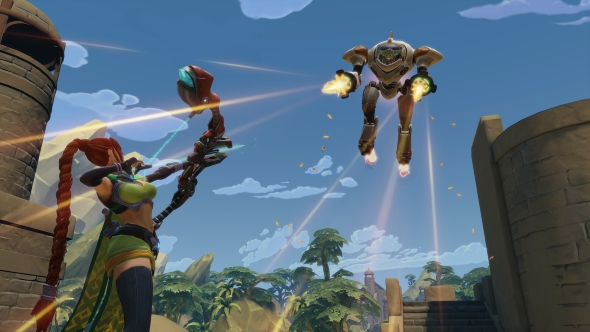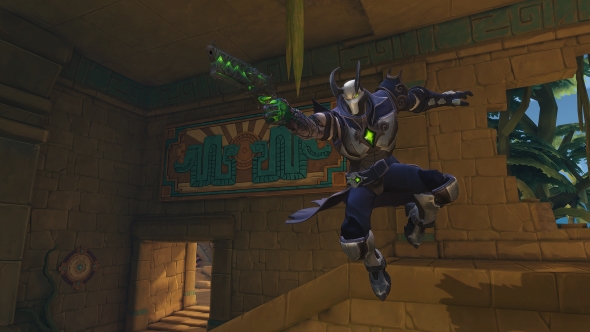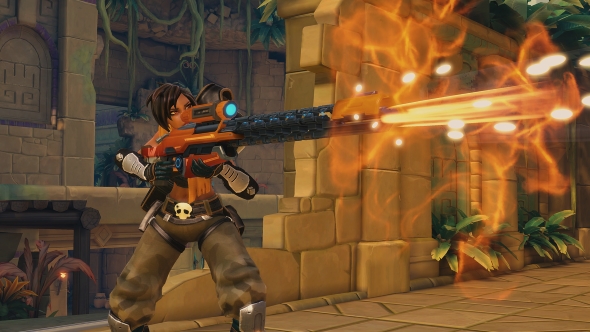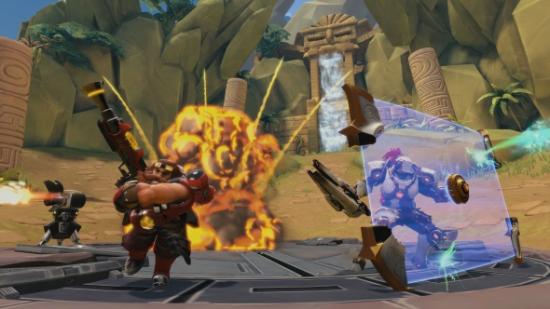The free-to-play section of Steam is a true battlefield. Many soldiers go in, but only a handful of veterans manage to make it onto the hallowed ‘most played’ list. Dancing over the corpses of freemium games with dwindling player counts is Paladins; Hi-Rez Studios’ hero shooter. Despite being surrounded by accusations of being an Overwatch clone and only having been in open beta a few weeks, it’s consistently among the top hitters on the Steam most played list.
It’s something that’s come as a bit of a surprise to Hi-Rez.
Want to keep your spending low? Try a great free-to-play PC game.
One of the most-played games on Steam
“They like us! They actually like us!” laughs Todd Harris, COO of Hi-Rez. “We thought it was in a really good place, but we’ve been surprised because the number of people enjoying it is so massive. It’s very global in its appeal. Both of those things are satisfying.”
At time of writing, Paladins has seen a peak of 35,645 players in the last 24 hours. That puts it as the tenth most-played game on Steam. Not bad for a title that’s in beta and not even two months into public release. And among the likes of Dota 2, CS:GO and Civilization, it’s a bit of an oddity: a non-triple-A game with next to no hype. Yet it’s doing the numbers.
While unintended, Hi-Rez theorise that they really lucked out in terms of timing. Back when they started development, Overwatch wasn’t a thing, and LawBreakers wasn’t anticipated. But flash forward to 2016, and hero shooters are in vogue. “If you look at Steam, there’s two genres people are playing right now: a lot of shooters and a lot of MOBAs,” says Harris. “Paladins hits on elements of both of those genres, so I think timing is fortunate for us.”
“MOBAs have given players constant customisation, you can shift anyway you want with different characters,” notes Rory Newbrough, Paladins’ designer. “Bringing that to the FPS genre is something that people were ready and primed for this year.”
It’s Global Agenda 2. With horses.

Hi-Rez are pretty open about the fact that Paladins has been a real exercise in trial-and-error. A tale of constant iteration, the game has rarely stayed in one form for long.
“Every game we make starts out as Global Agenda 2,” smiles Newbrough, referring to the probably-never-gonna-happen sequel to Hi-Rez’s first game.
“There are 20 games within Global Agenda,” explains Harris. “And so, like with every Hi-Rez game, we started taking assets from it. We started with a core PvP experience that was somewhat Global Agenda-like. It had shooter mechanics, but also the concept of abilities. Then the other big idea was to add mounts and cards.”
The latter two elements are far from traditional, and they’re two of Paladins most notable features. Each match sees your champion prance into battle on the back of a horse that looks as if it escaped from Azeroth, while a card system augments your powers.
Those cards have been a bit of a design hurdle, though. “In phase one of the cards there was more randomness, more RNG. With cards you expect that,” says Harris. “But with shooters players don’t expect that. So there were months spent trying to find the right balance. Was it going to be a card game with guns, or a gun game with cards? We ended up as a gun game with cards, but they’re more a perk rather than RNG. That was just one phase of months of learning.”
While understanding why they had to make the change, Newbrough looks back fondly on the randomness of the original system. “That’s kind of what makes card games exciting, right? Every time you play the game it can be different, or sometimes you get a spike of excitement you didn’t expect,” he says. “At that time a lot of our users and ourselves agreed that it was one of the most fun versions of the game. The problem is when you’re playing a shooter, if someone randomly gets stronger than you and there’s no way to control that, it feels unfair.”
After months of testing and iteration, the cards system was replaced with something closer to a traditional equipment mechanic. “We even called it Loadouts so it’s clear that this is more of an augmentation system than it is a power spike,” explains Newbrough.
Learning lessons from the gods

Part of what’s helped get Paladins on the road to popularity so quickly is rooted in the lessons Hi-Rez learned while creating Smite, their god-battling MOBA. Their success in the freemium arena certainly helped develop the approach for Paladin’s business model, which in turn dictates the way the game’s features work.
“With Smite we saw that it’s primarily cosmetics people buy, if they get attached enough,” says Harris. “So the Paladins team has embraced that system. It has even more customization options. With Smite you get a full character skin, where in Paladins you get a three piece system with your head, body, and weapon.”
It’s not just in the microtransactions, though. With their success with the Smite World Championships, Hi-Rez have learnt how to get Paladins ready for eSports. “We happen to be in a situation where the community has embraced Smite, and a lot of its systems already work with Paladins,” explains Harris. “There is a spectator mode already, a custom match lobby where you can set different parameters and picking of champions. Those kind of things just came along for the ride.”
The studio believes that you can’t create an eSport from scratch (only the community can decide if your game will go pro), but their implementation of sporting features is already paying off. “I’m pleasantly surprised about the appetite for eSports this early,” smiles Harris. “With Smite it was pretty early as well, but with Paladins it’s even earlier.”
That appetite is fed by an invitation-only tournament that will be held at Hi-Rez Expo, the developer’s annual celebration, in Atlanta next January. Players from all over the world will attend, and it’s proving very popular. “Brazil had closed up sign-ups within an hour or two,” enthuses Newbrough.
There’s no such thing as ‘too many champions’

Team and hero-based shooters tend to have a small amount of characters. Team Fortress 2 has a slim line-up of nine, while Overwatch has 23. Paladins currently has a traditional-sized roster of 19, but don’t expect that to last. Hi-Rez are looking to go MOBA with their character variety, with hopes of rivalling the 82 gods that are playable in Smite.
“There’s a reason why we pushed so hard to have a role system in the game,” says Newbrough. “We have Front Line, Support, Damage, and Flank, and that really allows you to build inside of them.” He envisions a future where each of these roles have numerous champions available to play as.
“It’s a very scalable system, as we’ve seen in Smite and other MOBAs. We can very easily scale that up to the high 60s or high 70s,” he adds.
Harris agrees that that’s the aim: “We’re already setting some of those expectations with the community. This is going to be a little more MOBA-like as far as the numbers of champions go,” he says.
Paladins’ initial success suggests that Hi-Rez are onto something. With what looks to be a well-attended debut tournament at Hi-Rez Expo, and tens-of-thousands of people playing each day, perhaps they really have re-bottled the same lightning that struck with Smite. Provided they foster it with the same dedication that their flagship MOBA receives, it’s not hard to believe that Paladins will be a mainstay on the Steam most-played list for some time.
